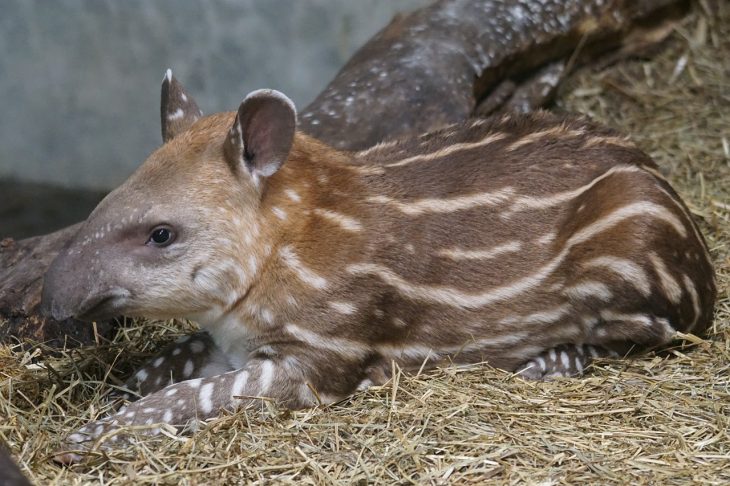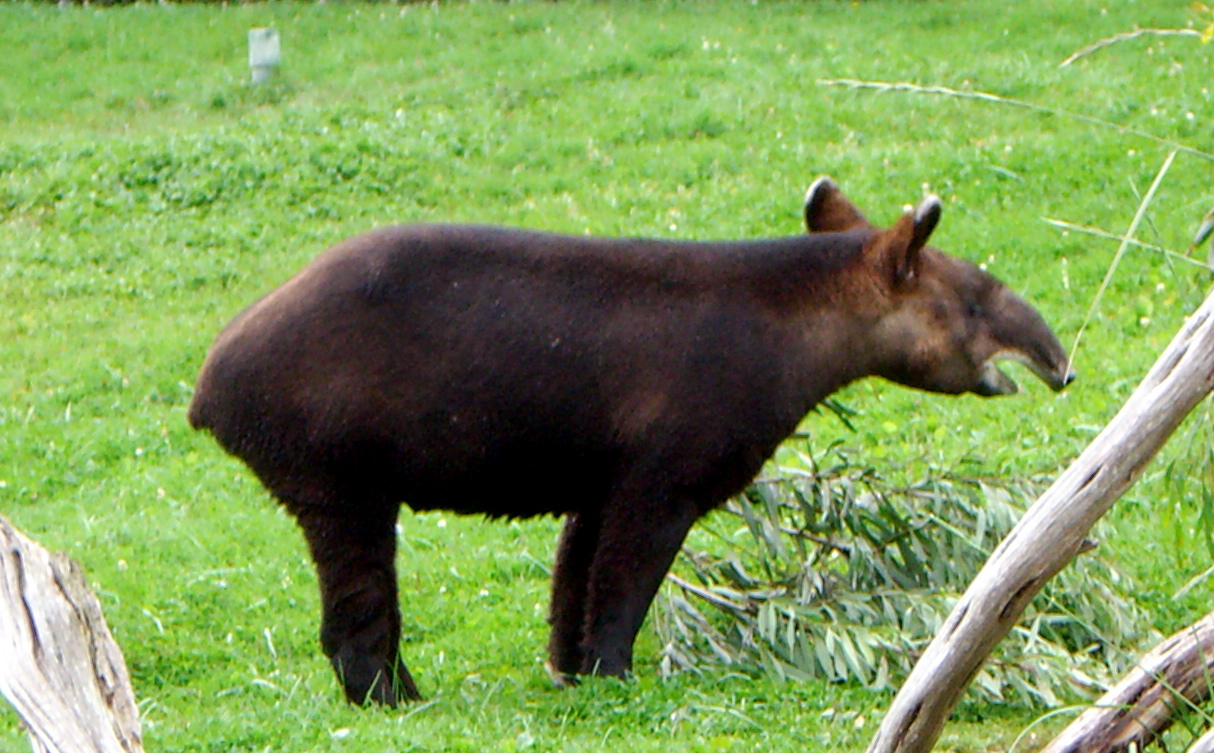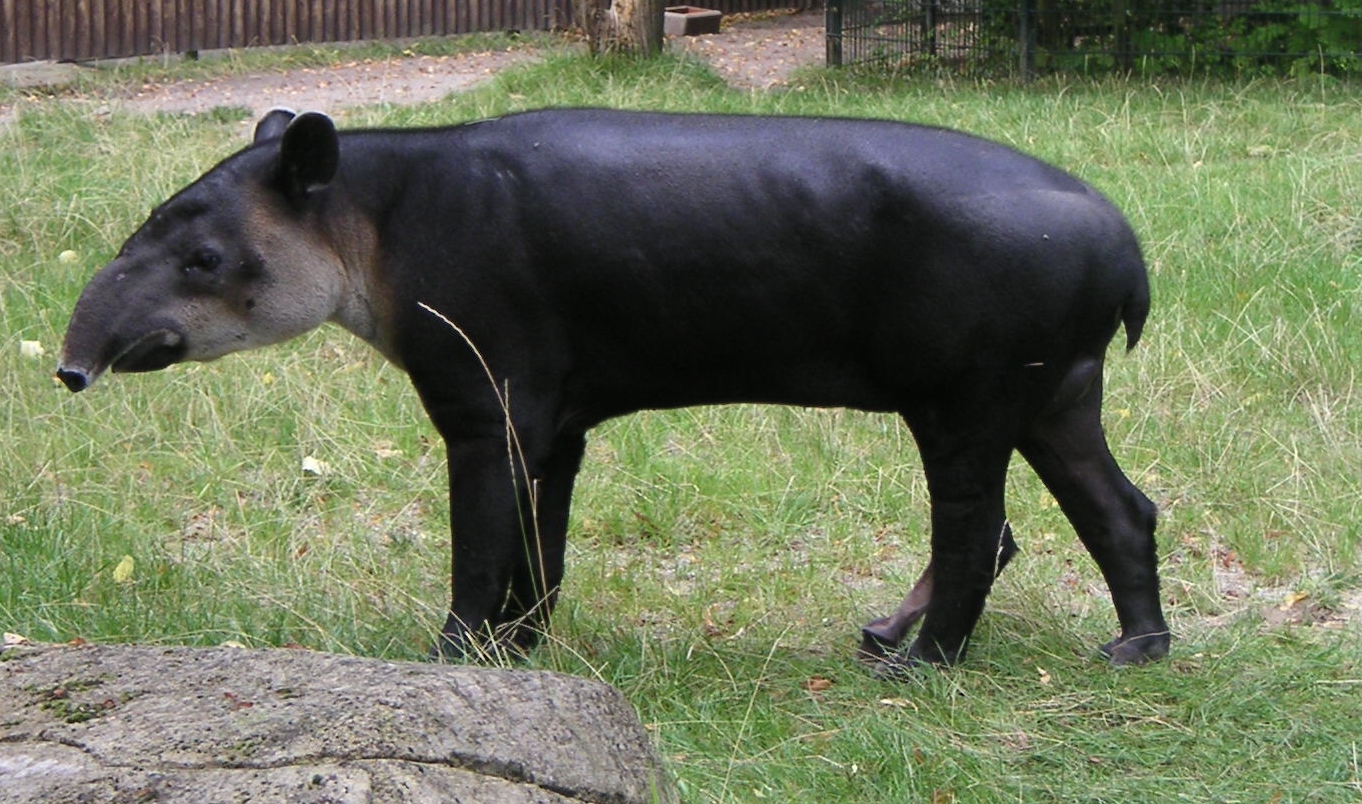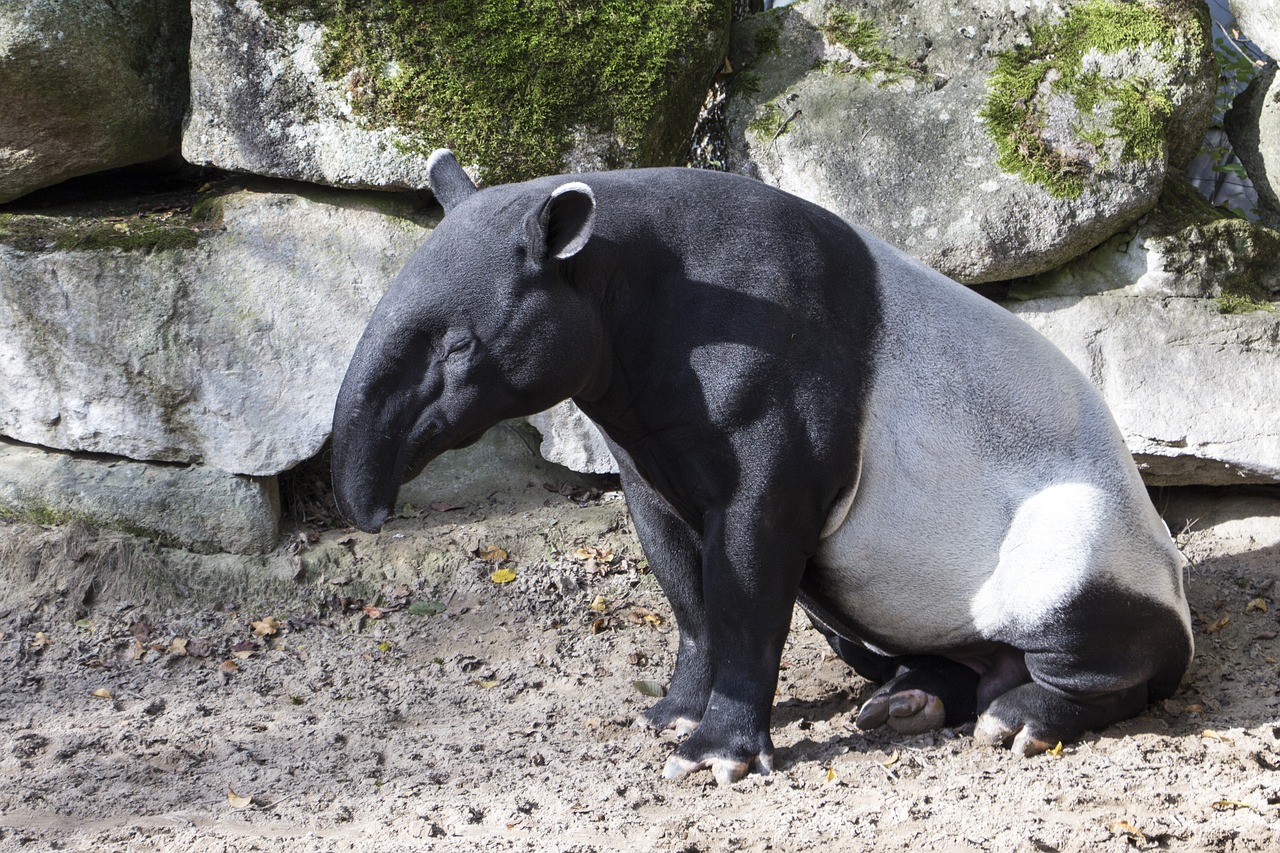
Tapirs may look like pigs at first glance, but this unique animal is more similar to horses and rhinoceroses. Seeing a tapir for the first time can be quite an experience! It can stand up to six feet and five inches tall and can weigh about 500 kilograms (1100 pounds). How’s that for some interesting number-based tapir facts?
The tapir’s adaptations have helped them survive on our planet for a very long time. Giant Tapirs, a species of tapir that originally lived in southern China, first appeared millions of years ago. It may have lived until 9,000 years ago, based on scientific records. Unfortunately, their descendants are now facing the threat of extinction. There are only around 5,000 tapirs remaining in the wild, and even these numbers are dwindling due to poaching and habitat loss.
Humans are, without a doubt, their greatest threat. People have been hunting tapirs for many years both for their meat and for their skin. This is a disheartening fact, as tapirs are known to be one of the most gentle sentient beings in the world. Their biological life cycles promote plant growth and help sustain biodiversity. For this reason, they are known as the gardeners of the forest. Quite mystical, right?
Enjoyed our rundown of tapir facts? We’re just starting. Check out our list of the 50 heaviest tapir facts.
- There are four species of tapir: the Malayan tapir, South American tapir, Baird’s tapir, and the mountain tapir.
- A Malayan tapir can be as heavy as 362 kilograms, or 800 pounds, according to National Geographic.
- The South American tapir approximately weighs 170 kilograms or 374 pounds on average.
- Mountain tapir usually weighs about 150 kilograms or 330 pounds.
- Baird’s tapir can weigh more than 300 kilograms or 660 pounds.
- A tapir is a herbivorous mammal. It feeds on plants, fruits, and other natural food for nutrition.
- The tapir’s proportions are comparable to a pig’s.
- They have a short prehensile nose trunk, which they use for grasping or holding.
- Some pronounce tapir as tay-peer or ta-pir.
- They also love to consume aquatic plants.
- Tapirs live in the forest regions of Southeast Asia, South, and Central America.
- Tapirs have been evaluated by the International Union for Conservation of Nature as Endangered or Vulnerable.
- Tapirs had several extinct relatives in the superfamily Tapiroidea.
- Some of the closest extant relatives of the tapirs are the other odd-toed ungulates such as donkeys, rhinoceroses, zebras, and horses.
- A tapir’s lifespan can range between 25 to 30 years.
- Some researchers stated that there’s a fifth species of a tapir called the Kabomani tapir.
- However, many experts dispute the existence of the Kabomani tapir. Instead, they classify it as part of the South American tapir species.
- Currently, the Kabomani tapir is only a partially recognized species of tapir.
- Some of its oldest fossils date back to 50 million years.
- Tapirs are excellent and agile swimmers. They can also dive for their favorite aquatic plants.
They can run more than 45 kmph.
Fast tapir facts! Tapirs can run 45 kilometers per hour. They can easily maneuver their heavy bodies in the forest, using four toes on its front feet and three toes on its hind feet. They rely on short bursts of speed to do so.
Female tapirs are usually bigger than the males.
All tapirs species have oblong white-tipped ears and circular protruding rumps along with stubby tails. Their hoofed toes allow them to walk effectively on muddy or soft ground. Size-wise, males tend to be smaller compared to females.
The Giant Tapir weighs about 500 kilograms or more than a thousand pounds.
One of the extinct species of tapir, the Giant Tapir or Tapirus Augustus used to live in southern China. Scientists think they also roamed the lands of Vietnam, Taiwan, and Borneo.
Data indicates that this species first appeared millions of years ago and may have survived until 9,000 years ago. As its name suggests, it’s bigger than our average tapirs today. According to estimates, it can stand more at around six feet and five inches and weighs about 500 kilograms or 1,100 pounds.
Tapirus californicus once inhabited the lands of California.
Also known as the California tapir, the Tapirus californicus is an extinct species of tapir that lived around 2 million years ago and was seen up to 13,000 years ago. The California tapir is assumed to be a solitary animal and populated mainly the coastal regions of Southern California all the way to Oregon. Based on research, they stayed in forested surroundings like grasslands, those that were close to rivers and lakes.
Tapirus copei and Tapirus merriami were the biggest tapirs that lived in North America.
The Tapirus copei or more commonly known as Cope’s Tapir is another extinct species of tapir that lived in North America millions of years ago. Some of its fossils were collected in Hillsborough County, Florida in the early ’60s. Basing on its fossils, the Tapirus copei is one of the biggest tapirs that trampled North America, along with Tapirus merriami or Merriam’s tapir.
There are more than ten known extinct species of tapirs.
Currently, there are about 16 known extinct species of tapirs all around the world including Tapirus cristatellus, Tapirus johnsoni, Tapirus greslebini, Tapirus mesopotamicus, Tapirus veroensis, Tapirus webbi, and Tapirus lundeliusi.
The mountain tapir has a longer and woolly fur than the usual tapir.

In general, the tapir’s coat is short, although it can have an array of colors from grey, to reddish-brown, to black, and white depending on its species. However, one species stand out from the rest, the mountain tapir. This particular tapir is distinguishable for its fur similar to those found on mammoths.
Male tapirs have a long penis.
The sexual organs of tapirs add to their otherworldly quality. Female tapirs have a single pair of mammary glands while male tapirs have very long penises compared to their body size.
They can't reproduce rapidly.
Unlike other mammals, tapirs can’t reproduce rapidly. A female tapir’s pregnancy can take time between 13 to 14 months and it usually results in only one offspring.
Calves can start walking right after birth.
Tapir calves or baby tapirs are born with their eyes open. Right after birth or instantly, calves are able to stand and walk. Calves usually stay with their mothers for 12 up to 18 months. They can wean or withdraw from the supply of their mother’s milk as early as four months, and start eating a growing tapir’s normal diet.
Its dental formation is similar to equids.
The tapir’s dental formula is comparable to the equids or mammals such as horses and zebras: 3/3, 1/1, 4/3-4, and 3/3 for a total of 42-44 teeth. Their incisors are chisel-shaped while their canines are conical.
Big cats are its main predators.
Big felines such as jaguars, tigers, and cougars are the main predators of tapirs. Tapirs have relatively few natural predators. Arguably, humans are its biggest threat. In fact, humans have hunted the tapirs for many centuries now to eat their meat and to use their hides for crafts. Crocodiles are also known to attack tapirs.
Tapirs are at a high risk of extinction.
It’s estimated that there are only less than 5,000 tapirs left in the wild. This fascinating and “bizarre” looking creature that looks like a combination of an elephant and pig is at a high risk of extinction due to poaching and habitat destruction.
They can bite for self-defense.
Tapirs are normally aloof. But when frightened, tapirs can use their powerful jaws to defend themselves. In 2006, a man who works in the government of Costa Rica got lost in Corcovado National Park, (a National Park in southwest Costa Rica), where he got some nasty bites from a wild tapir when he encountered it. Don’t make a tapir angry!
A tapir in captivity attacked a two-year-old girl.
In 2013, a two-year-old girl sustained wounds and injuries after her encounter with a South American tapir at Dublin Zoo in Ireland. That event was a supervised activity, and no one ever thought an accident like that would occur. Yikes! Authorities charged the zoo with a hefty fine for breaching health and safety regulations.
Tapirs by nature like to avoid any kind of confrontation.
The 2013 tapir attack on the two-year-old girl was not the first incident of its kind. In 1998, a tapir in captivity attacked a zookeeper working in an American zoo. The surprising event occurred when the zookeeper walked into the place where the tapir was staying. We could say that both the zookeeper and the tapir were surprised by each other’s presence. Despite these incidents, tapir attacks on humans are not common as tapirs tend to get terribly shy.
The Tapir Specialist Group is established to preserve tapir life.
As tapirs are slowly decreasing in numbers, several conservation projects have already started globally. The Tapir Specialist Group was built to help conserve the biological diversity of tapirs. They do this by developing, stimulating, and conducting effective programs to save each different species and their surviving habitats in Southeast Asia, Central America, and South America.
Baird's Tapir Project of Costa Rica is the longest ongoing tapir project in the world.
Established in 1994, the Baird’s Tapir Project of Costa Rica is the longest ongoing tapir project in the world. The project entails putting radio collars on tapirs in the country’s Corcovado National Park to effectively monitor and examine a tapir’s social systems and habitat preferences.
Another tapir conservation is now active in Brazil named The Lowland Tapir Conservation Initiative, which is founded by Dr. Patrícia Medici. The group promotes research and conservation of lowland tapirs and their remaining natural environments in Brazil.
Baird's tapir is a species of tapir endemic to Mexico.

Also known as the Central American tapir, Baird’s tapir is a species of tapir endemic to Mexico, South America, and Central America. This species received its name from the American naturalist, Spencer Fullerton Baird. The Baird’s tapir has a mutual relationship with the Yellow-headed Caracara and the Black Vulture as these two birds have been spotted to remove and eat ticks from Baird’s tapir or better known as symbiosis.
Baird's tapir is the national animal of Belize.
Also known as the “Mountain Cow” in Belize, Baird’s tapir is the country’s national animal. Although tapirs, in general, are nocturnal, Baird’s tapir can be active at any given time.
Furthermore, Baird’s tapir regularly stays close to the water as it loves to swim or wade, particularly on warmer days. They can rest in the water for several hours, exposing only their heads above water.
The Malayan tapir has poor eyesight.
Malayan tapirs don’t have the best eyesight so they rely mainly on their superior sense of hearing and smell. Many centuries ago, the Malayan tapir lived in the tropical rainforests of Southeast Asia including Vietnam, Cambodia, Myanmar, Indonesia, Laos, Malaysia, and Thailand. However today, Malayan tapirs almost nowhere to be found on these lands as their numbers have diminished dramatically over the last decades.
The Malayan tapirs can eat over 100 different species of plants.
The Malayan tapirs are observed to feed on over 100 species of plants. Like most of their fellow species, they like to live near water and would regularly bathe or swim as well, hence why they also like to munch on aquatic plants. They can also climb steep slopes thanks to their hooves made for the activity.
Experts consider Malayan tapirs to be crepuscular animals.

Although Malayan tapirs are mostly active at night, this species is not completely nocturnal. Malayan tapirs eat early after sunset or before sunrise and will usually take a nap in the middle of the night. It falls under the category of crepuscular animals, animals that are active during the twilight period.
The Brazilian tapir is the largest surviving native terrestrial mammal in the Amazon.
Also known as the South American tapir, the Brazilian tapir is the largest surviving native terrestrial mammal in the Amazon. The Brazilian tapir reaches sexual maturity in its third year, and would normally mate between the months of April and June.
The mountain tapir is the smallest species of tapir.
The mountain tapir is the smallest of the four recognized species of tapirs. Moreover, it’s also the only one that can live outside the tropical rainforests and other topographies. They thrive in the Eastern and Central Cordilleras mountains in Ecuador, Peru, and Colombia.
Mountain tapirs pee to mark their territories.
To announce their territory, male and female mountain tapirs usually urinate on trees. The territories of each individual usually overlap, as each tapir can claim over 800 hectares or 1,976 acres. Females tend to get bigger territories than males, though.
Tapirs can grab objects using their snouts.
The tapir’s upper lips can be stretched out into long snouts much like the elephant’s trunk. Accordingly, they use it to grasp things for eating. They can even use it as a snorkel when swimming by simply poking out their snouts out of the water. Cute tapir facts!
Tapirs have their own unique sound.
Some people may think that tapirs sound like cows, horses, and especially, pigs. But actually, tapirs have their own sound which is close to the sound of suddenly hitting the brake of a speeding car.
They can eat more than 70 pounds of food per day.
Tapirs eat a lot in general and have been observed to consume over 70 pounds of food per day. That’s a lot of food, but you can’t stop animals who love to eat like tapirs!
Hypno and Drowzee from Pokémon are tapirs!
Cool tapir facts, especially for Pokémon fans! If you are a Pokémon fan, you may have noticed that the characters Hypno and Drowzee look like tapirs! You are right on the money! The design of the psychic characters was inspired by tapirs as according to the Japanese legends, tapirs consume nightmares and dreams.
Was this page helpful?
Our commitment to delivering trustworthy and engaging content is at the heart of what we do. Each fact on our site is contributed by real users like you, bringing a wealth of diverse insights and information. To ensure the highest standards of accuracy and reliability, our dedicated editors meticulously review each submission. This process guarantees that the facts we share are not only fascinating but also credible. Trust in our commitment to quality and authenticity as you explore and learn with us.
